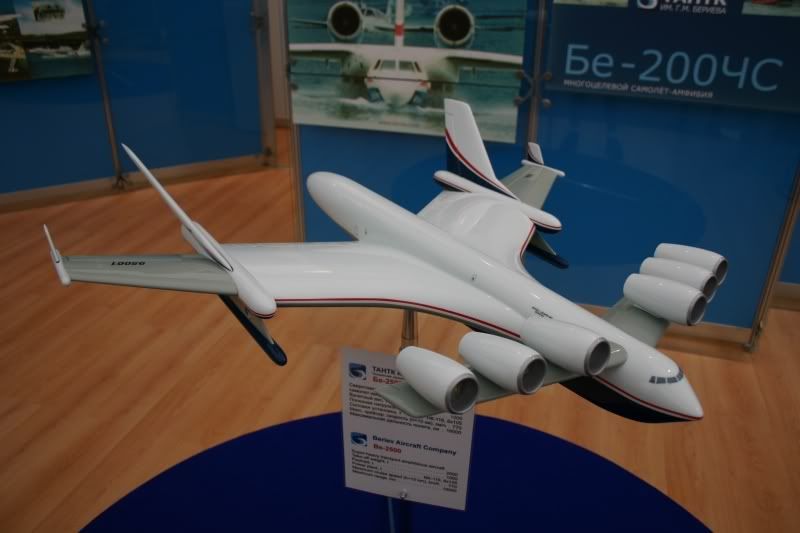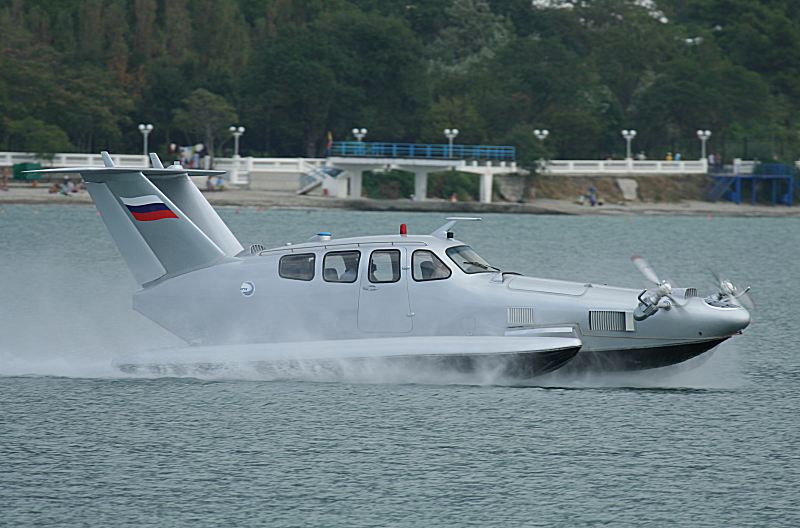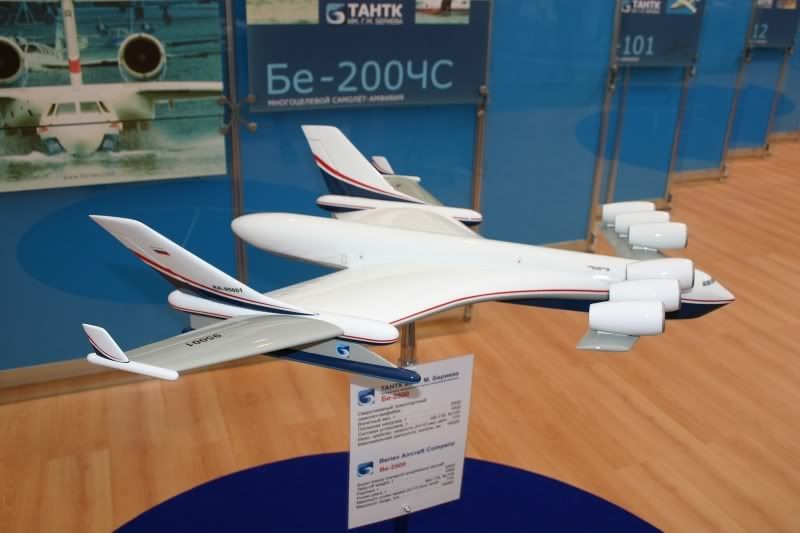 |
 |
| practically a very effective and low cost design, |
As for some my comrades who have no idea of this crazy but very practical and very applicable design of vehicle here is some idea of ekrnoplans, these crafts are also known as GEV's or ground effect vehicles according to wikipedia; A ground effect vehicle (GEV) is one that attains level flight near the surface of the Earth, made possible by a cushion of high-pressure air created by the aerodynamic interaction between the wings and the surface known as ground effect. Also known as a wing-in-ground-effect (WIG) vehicle, flarecraft, sea skimmer,ekranoplan, or wing-in-surface-effect ship (WISE), a GEV can be seen as a transition between a hovercraft and an aircraft. The International Maritime Organization (IMO) has classified the GEV as a ship. A GEV differs from an aircraft in that it cannot operate without ground effect, so its operating height is limited relative to its wingspan. ekranoplans have short stubby wings instead of longer ones, ekranoplans skim only above the surface of the water, mainly the relative distance between the water and the ekranoplan's hull depends also on the craft's wingspan, most ekranoplans are built with either turbo or jetprop and jet engines.
Soviet Ekranoplans
the former USSR was said one of the top and most viable users of WIG and GEV aircrafts, until now, the former soviet nations especially Russia, has perfected the designs and principles of GEV and WIG designs, notable soviet hydrofoil designers and researchers were funded highly by the soviet state to improve its designs and make it militarily and civilian capable, notable design companies included the Alexeev and Beriev design bureaus. in which if it was not cut of military funding the ekranoplan and similar GEV and WIG crafts became standard weapons in the soviet arsenal.
 |
| Soviet development of WIG and GEV vehicles |
A-90 Orlyonok Class
Although only one KM (Russian abbreviation for prototype ship) has been built, there were several variations, differing in length and weight. All were intimidating and weird looking, designed to use the ground effect to skim the ocean at high speed, undetected by radar. According to military sources, the Soviet government planned to built 100 of these monsters at the height of Cold War, then the number went down to 24.
accidentally the large KM model accidentally ran aground and was never recovered and sits somewhere in a 20M shallow area in the caspian sea, but because of this; the design gave way to the smaller and stable A-90 and other smaller ekranoplan designs
 |
| The KM Class Ekranoplan is the largest Ekranoplan the former USSR Built. |
 |
| The SM-8 a smaller design |
 |
| This are some smaller designs of ekranoplans based on the KM Class |
LUN class
The last Ekranoplan from the former Soviet Union was the LUN. It weighed 400 tons and was built in 1987 with 100% military application as a missile launcher / troop ship. It carried six large missiles on top of the fuselage, and could carry tanks and trucks in its large cargo hold. Also it must be said here that it would not have been detected by radar as it would have traveled under the radars waves.
It could reach speeds of up to 550 knots which is unprecedented for what is basically a water based vessel. No enemy ships would have had the slightest chance of intercepting this vehicle by any means due to this high speed of travel.
The Lun is armed with 8 Moskit anti-ship cruise missile launchers and nicknamed “the killer of aircraft carriers” it was capable of flying and firing in the conditions of 6-7 grades storm.
today, the lun and orlynok ekranoplans are being mothballed in several locations around the russian federation, but according to the armed forces of russia, this vehicles are reserved for scientific and improvement purposes.
Beriev VVA-14
The first prototype, designated VVA-14M, first flew on 4 September 1972 from Taganrog.
Later it was fitted with inflatable pontoons for vertical take-off and short take-off from water. 12 RD36-35PR turbojets were installed for providing lift at cushion take-off.
In 1976 a VVA-14 prototype was converted to a VVA-14M1P, the inflatable pontoons were replaced by rigid ones and two additional D-30M turbofans were installed at the nose of the vehicle. These engines blow in the cavity under the wing for PAR take off.
Raketa 2
The Raketa 2 is very similar in layout to the Volga 2 but has a third engine in the fin. It is a view of the Design Bureau for larger WIG craft for inland waterway use and it has not been built. The Raketa can accomodate 90 passengers and it has three 1785 kW TV7-117 turboprop engines, two for take-off and one extra for cruise.
Trends
GEV developed since the 1980s have been primarily smaller craft designed for the recreational and civilian ferry markets. Germany, Russia and the US have provided most of the momentum with some development in Australia, China, Japan and Taiwan. In these countries small craft up to 10 seats have been designed and built. Other larger designs as ferries and heavy transports have been proposed, though none have gone on to further development.
Newer designs
Small Aircrafts
KM aquaglide
In russia, smaller versions are being made for private commercial usage also capable of navigating in grade 2 stroms and is now under mass production and manufactured under the trademark "Aquaglide"
Aquaglide is a high-speed craft belonging to A-class ekranoplans (WIG craft) according to International Maritime Organization (IMO) classification.
The cruising speed of "Aquaglide-5" is about 170 km/h. No other sea or river type of passenger craft (a liner, a motor boat or a hydrofoil) can compete with Aquaglide by this parameter. Transition to the cruising speed (lift off) happens at a speed of 90-100 km/h. This speed is reached within 40-50 seconds when the craft is moving on the obstacle-free waters or on the ice-covered waters. When moving as a motor boat (partially immersed in the water) Aquaglides may reach the speed of 80-90 km/h by manipulating with the air pressure in the floats.
Chinese ekranoplans "yellow sea monsters"
And it also seems the chinese are also interested in the GEV and WIG here are a number of models of GEV and WIG aircrafts under testing by different design bureaus in china, most of the bureaus are in zejiang and jiangsu under the supervision of Chinese Ship Scientific Research Center (CSSRC), yet no info has been contributed lately due to chinese military censorship.
Beriev BE-2000 and BE-2500
The Beriev Be-2500 Neptun (Cyrillic: Бериев Бе-2500 Нептун) is a super-heavy amphibian cargo aircraft concept being developed by the Beriev Aircraft Company of Russia. Its maximum takeoff weight is projected to be 2,500 metric tons, hence the designation.
It is designed to function as both a conventional high-altitude jet and as anEkranoplan. It is intended to fly transcontinental routes, taking off from conventional seaports and requiring no special infrastructure.
there are 2 models of the beriev neptun being conceived; one is a cargo version(first pics above) and a passenger version (second pics above) which when hoped will become possible also military versions are available for transport, reconisense, and for maritime rescue.
so here is some videos of the ekranoplans;
this one is a japanese working model powered by 2 Wankel engines it made successful trial run and stayed up to 1 minute in the water surface.. (danny choo may not have this video but a big share for japanese otakus)
Later it was fitted with inflatable pontoons for vertical take-off and short take-off from water. 12 RD36-35PR turbojets were installed for providing lift at cushion take-off.
In 1976 a VVA-14 prototype was converted to a VVA-14M1P, the inflatable pontoons were replaced by rigid ones and two additional D-30M turbofans were installed at the nose of the vehicle. These engines blow in the cavity under the wing for PAR take off.
Raketa 2
The Raketa 2 is very similar in layout to the Volga 2 but has a third engine in the fin. It is a view of the Design Bureau for larger WIG craft for inland waterway use and it has not been built. The Raketa can accomodate 90 passengers and it has three 1785 kW TV7-117 turboprop engines, two for take-off and one extra for cruise.
Trends
GEV developed since the 1980s have been primarily smaller craft designed for the recreational and civilian ferry markets. Germany, Russia and the US have provided most of the momentum with some development in Australia, China, Japan and Taiwan. In these countries small craft up to 10 seats have been designed and built. Other larger designs as ferries and heavy transports have been proposed, though none have gone on to further development.
Newer designs
Small Aircrafts
KM aquaglide
 |
| the KM aquaglide-5 |
Aquaglide is a high-speed craft belonging to A-class ekranoplans (WIG craft) according to International Maritime Organization (IMO) classification.
The cruising speed of "Aquaglide-5" is about 170 km/h. No other sea or river type of passenger craft (a liner, a motor boat or a hydrofoil) can compete with Aquaglide by this parameter. Transition to the cruising speed (lift off) happens at a speed of 90-100 km/h. This speed is reached within 40-50 seconds when the craft is moving on the obstacle-free waters or on the ice-covered waters. When moving as a motor boat (partially immersed in the water) Aquaglides may reach the speed of 80-90 km/h by manipulating with the air pressure in the floats.
Chinese ekranoplans "yellow sea monsters"
 |
| Some models of Chinese ekranoplans |
Beriev BE-2000 and BE-2500
The Beriev Be-2500 Neptun (Cyrillic: Бериев Бе-2500 Нептун) is a super-heavy amphibian cargo aircraft concept being developed by the Beriev Aircraft Company of Russia. Its maximum takeoff weight is projected to be 2,500 metric tons, hence the designation.
It is designed to function as both a conventional high-altitude jet and as anEkranoplan. It is intended to fly transcontinental routes, taking off from conventional seaports and requiring no special infrastructure.
 |
| The many variant of designs of the Beriev Neptun |
so here is some videos of the ekranoplans;
this one is a japanese working model powered by 2 Wankel engines it made successful trial run and stayed up to 1 minute in the water surface.. (danny choo may not have this video but a big share for japanese otakus)
next is the biggest and Mother of all ekranoplans the KM and its children the Orlyonok and the Lun
in closing there are some disadvantages about GEV and WIG crafts but it is surpassed by more pros versus cons, some pseudo-intellects and academic persons around the internet still debate over this and some people, especially politically motivated ones (pro-americans and pacifists you know who you are) still could not accept that the Russia and former soviet states were able to perfect and even build larger GEV and WIG crafts and still be able to produce smaller ones.. to my fellow otakus out there, lets accept it, we humans get more idea and do the impossible and this one proof. we are capable building WIG and GEV vehicles...




















1 comment:
wow! even thou i'm a math teacher you really gave me more things to learn.. this vehicles are unique I must say I hope I can have one hehehe...
Post a Comment